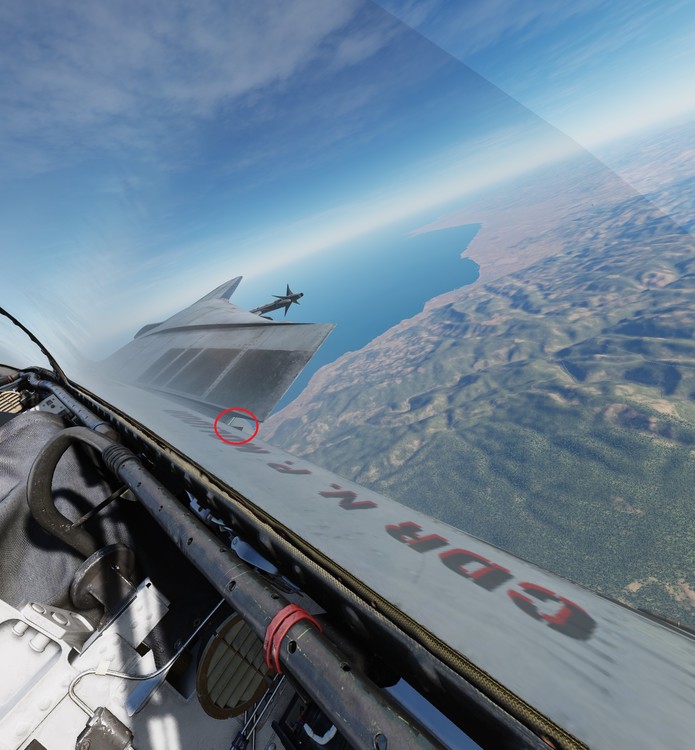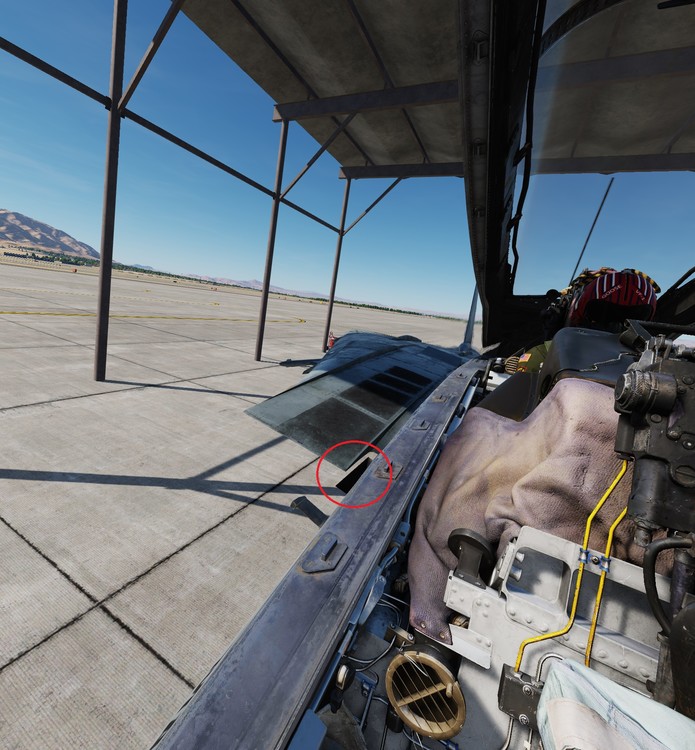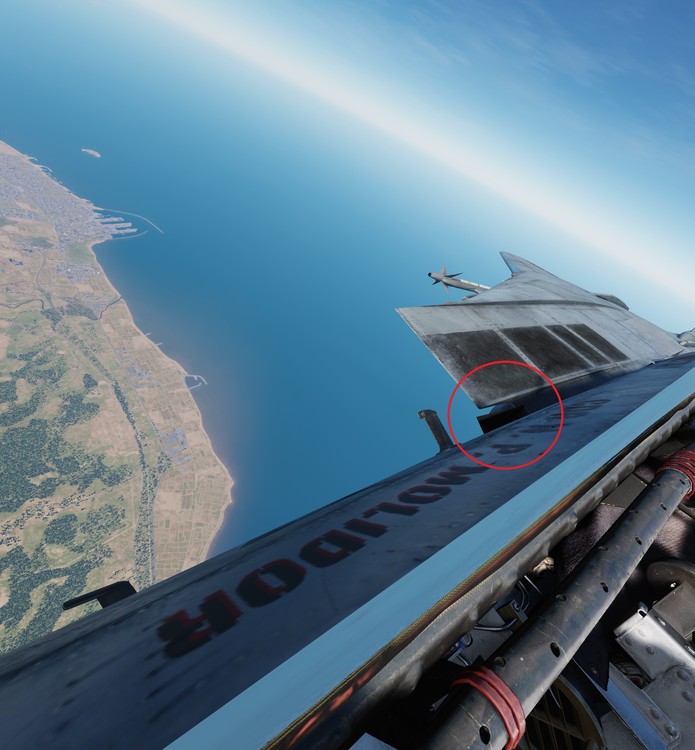-
Posts
315 -
Joined
-
Last visited
-
Days Won
1
Content Type
Profiles
Forums
Events
Everything posted by Quid
-
Last I heard, Virtual Forrestal's on a deployment and won't be back in dock until at least March 2021. Meanwhile, the AI A-6 is pending installation of a "Fortunate Son" switch and licensing so the AI can listen to the song on repeat for the entirety of a campaign in Vietnam just in case anyone releases that map. I'd say we have a bit of time to wait.
-
If you look at the right knee panel, you can see for the HSD settings "NAV, TID, ECM" under MODE and "ORIDE, OFF" under ECM. In the F-14B, you can't select ECM under MODE (I'm guessing this is because of the separate ALR-67 display), but per NATOPS for the F-14A, the "ECM" mode repeats the RIO's ECMD on the HSD, while "ORIDE" will display the ECMD for missile launches or airborne intercept signals automatically even if ECM mode is not selected. Not necessarily. Depending on your scenario, all of the BLUFOR Tomcats in the area might be F-14Bs. If you were running a crisis scenario in early 1992 and had both the Saratoga and the Eisenhower in the area, you'd have more than 40 F-14B slots (VF-74, 103, 142 and 143), and no F-14As.
-
Not sure what you mean/are expecting? Engine thrust is highly dynamic; it's been discussed a number of times on these forums, but to put it far too simplistically, as speed increases, thrust increases, as altitude increases, thrust decreases. The result can be shown as a power curve at a given altitude. The Tomcat has a variable inlet, so at lower altitudes it actually starts losing thrust for a bit as the jet goes from high transonic to supersonic and the ramps deploy to full (smaller inlet area), before thrust starts increasing again. The difference between the TF-30 and the F110 is that the F110's computers start ebbing the thrust off as the jet gets to very high speeds (esp >1.6M), while the TF-30 just keeps producing more, so at high speed and high altitude, the TF-30 eventually starts outputting higher thrust than the F110. Drop down to about 35,500 and you'll get 2.35 out of the B if it's clean.
-
It depends on the model and when. For the normal accelerometer, you can just reset it. The engine FEMS in the F-14B and D tattled at 7.5g with an airspeed above .24M. Apart from that, I do recall reading the same, that eventually the plane itself after some point started recording max g regardless of if the accelerometer was reset, but I don't know when.
-
First time I recall hearing about the bleed-air turn-off for extra thrust was Hoser discussing using it in a bugout. Referred to it as "Zone 6," (a play on the 5 zones of the TF-30's afterburner), and it was used by several crews during ACE/AIM under specific circumstances. Not sure how much you'd want to rely on it, but if HB is making it a simple keybind, that's a nice little addition.
-

Fight for Honor - A Folds of Honor Charity Event
Quid replied to M0ltar's topic in Tournaments & Events
He didn't fly against Sungho, he flew WITH Sungho after he won the first FFH tournament. You can see it here: EDIT: Also, what Dino Might said. I actually took up a Spitfire this time, totally unpracticed due to my laser surgery. Went up against a Hornet. It was ridiculously fun, and I lost (it's bad enough being out of practice, but add the fixed gunsight and it didn't matter how many firing opportunities I got!) It's a friggin' charity event, it has its rules defined, and they are part of the challenge. -

Fight for Honor - A Folds of Honor Charity Event
Quid replied to M0ltar's topic in Tournaments & Events
Just signed up. Not expecting to win at all, why? I just had PRK and can't practice, so I'll be coming in cold. Regardless, I'll suck with confidence, lose with honor, and know I helped a good cause! -
I can see this just becoming little more than "well ackshually" hair-splitting nerd bickering, so I'm not going to say anything beyond this here. Fighter generations in general are little more than an easy way to bin roughly similar capabilities and are not uniformly defined to begin with. Technically, I could argue the F-15 is a Third Gen fighter until at least the 1990s because from an overall capabilities standpoint, it was no advance over the F-4, indeed, it lost capability (no strike) - it was a Fox 1 shooter with no advanced SA (D/L) or multi-target engagement capability. That's on par with the prior generation, not an advance. But, if you take it from the "the Fourth Generation are aircraft built with the lessons learned from Vietnam, with an emphasis on maneuverability, 360-degree visibility, dogfighting radar modes" (etc.), you've got all of the Teen-Series in it. In the 1970s, both the Tomcat and the Eagle were referred to as either service's "Next Generation" fighter, hence both are follow-ons to the F-4, and both are again of the same generation. So, have your opinion on the matter, I disagree, I guess. But, this is also off-topic. Hopefully, OP finds his VR headset helps him with the windscreen.
-
The tri-piece windscreen had been the standard for a long time. The thing is, in VR, it's not nearly as big a deal. I almost never lose tally anymore since I've gone to my headset, but I will say that yes, it got in the way more noticeably and you still have to move your head around sometimes. The F-14 first flew in December 1970, the F-15 in July 1972, the F-14 entered operational service in September 1974, the F-15 in January 1976. They are very contemporary. Hell, from the 1970s to the 1990s, the F-14 was arguably the more advanced: the Tomcat had data link, the Eagle didn't. The Tomcat had a functional, useable TWS capability, the Eagle did not. The Tomcat had a Fox 3 missile, the Eagle did not. The Eagle's radar was a better fighter radar from the get-go with MPRF and fully-digital design, but all told, both the Tomcat and the Eagle are comparable and considered of the same generation. Your comments on VR are exactly what I find as well. Even in TrackIR I had more difficulty keeping tally, still not debilitating, but I just notice in VR it all seems to work naturally and I don't really have problems keeping tally.
-

Multiple Radar/AWG-9/Phoenix Issues since patch 2.5.6.52437
Quid replied to Bearfoot's topic in DCS: F-14A & B
Worked for me two nights ago on the 107th Through The Inferno Syria server. While there was ghosting for a bit, I reviewed the TACVIEW, and there were points when the bandits were flying circular patterns, or maneuvering relative to other blue assets, so the ghosting wasn't likely caused by a bug for me, but rather because of the dynamic way in which the targets were flying. -
Hello, I've been putting a bit of time in with the Turkey now that I've got a VR headset. After taking some time after a CAP just to fly around and enjoy the modelling of the plane and terrain, I looked back over my shoulder for a moment, then caught something weird. There appears to be a jagged artifact sticking out the starboard and port sides of the aircraft. I never noticed it before with TrackIR, but that could just be because I wasn't looking at the angle. Two of the shots are with a default skin (VF-102) one is with a custom skin (Maverick & Goose VF-1). It clearly isn't one of the probes, and it isn't there in the external view, so I figured I'd report it as a possible bug. See attached images with red circles highlighting the apparent artifacting. Cheers.
-
If it's a mid-90's Tomcat, those will absolutely be there as they are on the B. They were introduced in 1982 (so, an Iranian Tomcat wouldn't have them, but I'm guessing HB isn't going to remodel the cockpit for that, and frankly I don't care). As to how it activates, paraphrasing the NATOPS, the system has two feeds per engine: ratio of TIT/N (turbine inlet temperature/compressor rotor speed) compared to a preset value, and an over-temperature condition exceeding 1215+/-15 degrees Celsius (for the TF-30). If either condition is met, the STALL warning light of the affected engine located on the side of the HUD flashes at 3 Hz until the condition is cleared. The stall warning tone is activated through the pilot's intercom for up to 10 seconds. The system may activate during ground starts or air starts. I've actually gotten one to light up in the F-14B, but I don't remember hearing a tone with it. This was over a year ago when I was first testing out the Tomcat and was intentionally trying to spin it, so a lot of dumb stuff no one would ever do in real life. The right STALL warning light lit up very briefly, then cleared.
-
The "B" was the only one that got it; the F-14D had its own HUD, I think by Kaiser. The SparrowHawk was one of the systems installed into the F-14B (B-Upgrade) during the late 1990s-early 2000s along with the PTID, databus, etc. EDIT: The F-14D HUD was the Kaiser Aerospace AN/AVG-12.
-
GAO Report B-260367/NSIAD-96-98.
-
According to the -402 powered F/A-18C flight envelope, your top speed is going to be achieved at around 36,000-37,000 feet. I went ahead and tested it with a completely clean Hornet and it's just barely below the advertised 1.8M. The HUD held at 1.78M, while TACVIEW says 1.79M on the replay. This was on a 15 degree Celsius/29.92Hg day.
-
I have photos of Tomcats from the mid-1990s with the vanes still active, so, just because you didn't see them in a movie doesn't mean the system wasn't there. It means they weren't ever flying fast enough for them to program out, or the pilot didn't select them out for the sequences filmed. There's actually a good number of photos from the 1980s with the vanes rolled out and a few from the 1990s. Be that as it may, Heatblur has said it's going to be an F-14 with the vanes inactivated, so the whole thing is a moot conversation.
-
Given that the subject came up about chunking hours into the Tomcat, I figured this was related. Also, hi, Dave. I just tried the Tomcat in VR for the first time and holy Mother of God, Heatblur knocked it out of the park. I was impressed with TrackIR before. In VR, there is no comparison. I'm probably going to be stuck in the virtual pit for the next month or so; if no one hears from me, send an ambulance...or maybe a hearse...
-
You’d need a lot of different contexts because a lot of what you list is across a wide span of time. The maintainability question depended on available parts, engines and budgets. I’m guessing one of the videos you’re referencing from the 1970s is the ACEVAL/AIMVAL video where the Tomcat’s operational readiness was reported to be better than 90% (IIRC it was better than that, but I’d have to find the source again). This is because parts, engines, etc. were readily available and the teams were keeping up six aircraft (half a squadron). By 1980, “Hawk” Smith quipped that being a Tomcat squadron commander gave him two things in life he always wanted: to command a fighter squadron and to own a junk yard. He clarified that he wasn’t trying to disparage the plane, but the supply problems in the Navy at the time, and that half the Tomcats had bare firewalls due to engine shortages – a calculated dig at leadership to get the stuff the jet needed to work. As it stands, the F-14 had more black boxes in it that former generation aircraft that could be swapped faster, but did not have the fast-opening panels of later aircraft, removing and accounting for hundreds of screws which would need to be put back in when the work was done (one of the interviewees on the Fighter Pilot Podcast brings this up specifically). The Tomcat wasn’t retired because of maintenance; we’d have retired a lot more aircraft if that was the problem. It was multi-faceted; politics, end of the cold war, perceptions about roles, costs, savings by reducing number of airframes/parts/production lines, etc. The swing-wing box was very much the strongest part of the airframe, but there were points in time where metal shavings were found in the pivots and they had to be inspected. It did add complexity to the aircraft and was expensive, but Grumman studied a fixed-wing version and decided it would not as easily meet the Navy’s requirements, and would be heavier. Both of these things can be true at the same time, it’s a trade-off. When you compare any aircraft to any aircraft, the aircrew of that aircraft will say how much better they are than the other. It ALWAYS happens. An F-15 driver is flying the best airplane in the world. So is the F-16 driver. So is the F/A-18 driver. So is the F-14 driver. So is the F-4 driver. You will get all kinds of different responses, especially when someone is actively flying the aircraft and even more so when they’re inter-service. Tomcat drivers would say the exact same things about F-15s. I think the movie didn’t help, putting the F-14 squarely on the silver screen with laud and praise and pilots of other airframes constantly hearing about it and how great it is. > [Airframe other than yours] is the best! > (With eye twitching) No, it isn’t, and we beat up on them all the time. In fact, it’s probably the worst one out there. Heck, even Brand Y is better! We eat those guys for breakfast all the time! Not even a challenge! The AIM-54s use for fighters was caused more so by the fact that the AIM-7 didn’t provide a performance advantage against Soviet fighters as the MiG-29 and Su-27 got promulgated. The AIM-54 did. “Bio” Baranek discussed it in an interview. All of this stuff is out there, just read about it. It's funny because as I was writing my response, this came up. I heard the exact opposite from the Tomcat side - basically the first time they used VIFF, it surprised some Tomcat crews, and the Marines were yakking it up, but then when the Tomcat crews figured out "just do a high yo-yo" it became like "shooting fish in a barrel, we gunned four in a row once...not really a challenge." Goes right back to my point that everyone trash talks.
-
So, the AIM-54C started development before the Iranian Revolution but was accelerated in response to assessed/potential compromise - it was not started because of it. The statement about "Because the 54C was more complex and new it did not achieve quite the success that the 54A did in terms of probability of kill" is vague. That doesn't say "it was less maneuverable" (it wasn't, based on published figures) nor does it say anything about its physical performance. That could be a comment about the fact that several were fired in anger and missed on account of different reasons as compared to Iran's claimed victories with the 54A, or it could be a comment about test range performance, or it could be something someone said during a conversation at a bar. As it stands, this has become a rabbit-hole; I don't think any of us has adequately answered OP's original question, other than to say after a certain point (at least the mid-1990s), the missile had a Mk.47 MOD 1 motor in it and not a Mk.60. That said, if the sources are reliable and if the Aerojet contract ended in 1978 for the Mk.60, I'm guessing it wouldn't have been used for the AIM-54C.
-
I don't think that's correct. Work on the AIM-54C started in October 1976[1], three years before the revolution in Iran. The first 15 pre-production rounds were delivered in early 1980 for initial flight testing and firing. First launch of a pre-production AIM-54C using solid-state electronics was 2 June 1980 against a QF-4, which was a successful intercept[2]. The initial production batch of 30 was delivered to the US Navy 27 October 1981 with full production starting in 1982[3]. The decision to go with solid-state electronics was to improve reliability, ECCM capability, reduce internal heat generation to eliminate the complex cooling loops needed for the A and B models, and correct the gap in performance noted with the AIM-54A's ability to intercept a high-speed diving cruise missile. This wasn't some quick-reaction acquisition in response to the revolution, it was deliberately developed over years. Could the revolution have sped up the timelines to get the missile into service earlier? Possibly, but three years of development had already been undertaken by that point, so it wasn't the cause. I also don't really buy the second part. The C model was more maneuverable, fully digital (to include transmitter/receiver, programmable digital signal processor, autopilot and inertial reference unit), with an improved fuse, improved target discrimination, range discrimination, reduced drift, and better performance into beam attacks.[5],[6] That tells me the missile would not have had an arbitrary reduction in accuracy from the former, analog model. The weight differential was not substantial for a missile that size; only around 30 pounds. References: 1. Tony Holmes, Grumman F-14 Tomcat All Models 1970-2006 (UK: Haynes Publishing, 2018 ), 41. 2. Bill Sweetman et al., The Great Book of Modern Warplanes, (New York: Portland House, 1987), 634. 3. Ibid. 4. Jon Lake (ed.), Grumman F-14 Tomcat Shipborne Superfighter (UK: Aerospace Publishing London, 1996), 86-87. 5. Ibid., 87. 6. Draft Navy Training System Plan for the AIM-54 Phoenix Missile, June 1997, I-3.
-
According to Navy Training System Plan documents on the AIM-54 from 1997, by that point the AIM-54A, C, and C ECCM/Sealed used the Mk.47 MOD 1 motor. It doesn't mention the Mk.60 for propulsion. As it stands, I have a few books which include the same line from F.B. Newman from Hughes stating the very vague: "the AIM-54C was the model that had everything they'd ever wanted in it - a higher thrust motor, an improved warhead, and an improved fuse." The problem is: what is meant by "higher thrust" - it's utterly ambiguous. Other segments of the missile have been discussed with specifics (e.g., the AIM-54C had a 25g limit), or in at least a descriptive (e.g., the DSU-28C/B fuse allowed the AIM-54C to properly range/fuse/detonate against a high-speed cruise missile in a steep, high-angle, high-velocity dive which the AIM-54A's fuse could not reliably do), but the Mk47 MOD1 was "higher thrust" than the MOD 0 of the 1970s doesn't really say anything meaningful, unfortunately. EDIT: Further ambiguity is sources from the 1980s which list a general "Rocketdyne Mk.47 or Aerojet Mk.60" rocket motor for all variants of the AIM-54 that they list.
-
I've definitely had it happen before. The gunsight would disappear when the target was locked, but the basic diamond/cross would show up when I broke lock. I don't know if it's a bug, or if it was because I overstressed the jet. Given its irregularity, I'd guess the latter - it's been a few months.
-
Yes, but that's because the version of the F-14B we have had the same HUD as the F-14A. Don't expect that to change. EDIT: near_blind beat me to it.
-
This is true. The Standard Aircraft Characteristics for the Tomcat in 1977 put its weight at 39,037 pounds gross weight; the Iranian F-14s might have been slightly lighter or right about there. The F-14B is 43,600 pounds gross weight, so more than 4500 pounds heavier. Based on last night's experiments, I think the answer is absolutely yes if you chunk time into learning that approach. This!
-
It heavily depends on the year. The U.S. underwent a bit of inflation across the 1970's which adjusted the price, but so too did the order size (cutting back the total orders causes the unit price to increase). Tom Gervasi's "Arsenal of Democracy II" provides the following: "Price: $20.624 million (1978 Unit Procurement Cost for 44 aircraft). $19.025 million (1977 Unit Procurement Cost for 36 aircraft). $23.750 million (1974 Unit Program Cost for 80 aircraft sold under FMS to Iran, including unit procurement cost of $11.3 million and research and development surcharge)"[1] Across time, the cost increased. Wikipedia, IIRC, indicates a cost in 1998 dollars, so you'd have to adjust for inflation, but it was probably in the vicinity of the $30M range when the last F-14D came off the assembly line. I have no doubt that someone could find the exact figure. References: Tom Gervasi, Arsenal of Democracy II, (New York: Grove Press, 1981), 97. EDIT: I missed that this was specifically about the F-14B, but the point remains - unit cost changes based on year and production batch size.




